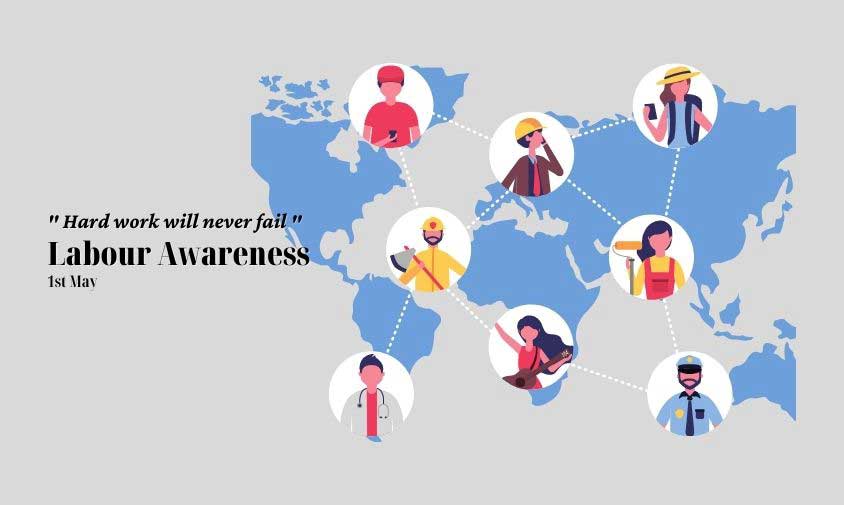Labour Day, or International Workers Day, is a public holiday celebrated on May 1 annually in many countries worldwide.
Labour Day celebrates workers’ social and economic achievements and the labor movement. It is often associated with demonstrations, parades, and rallies organized by trade unions and other labor organizations.

The origins of Labour Day can be traced back to the late 19th century when labor movements in the United States and Europe were fighting for better working conditions, fair wages, and shorter working hours. The first International Workers Day was celebrated in 1890 to commemorate the Haymarket affair in Chicago, USA, where workers were protesting for an eight-hour workday and were violently suppressed by police.
In many countries, including the United States, Labour Day is observed on the first Monday in September rather than May 1. In these countries, Labour Day is often viewed as a day to celebrate the contributions and achievements of the labor movement rather than a day to protest or demonstrate.
History Of Labor Day Or Mazdoor Day
Labor Day, also known as May Day or International Workers Day, can be traced back to the late 19th century when labor movements in the United States and Europe fought for better working conditions, fair wages, and shorter working hours.
In the United States, Labor Day was first celebrated in New York City on September 5, 1882. The event was organized by the Central Labor Union and was meant to demonstrate the strength and solidarity of the labor movement. The celebration featured a parade of workers and their families, followed by speeches, picnics, and other festivities.

The idea of a national holiday to celebrate the contributions of workers gained traction, and in 1887, Oregon became the first state to declare Labor Day a public holiday. Other states followed suit, and in 1894, President Grover Cleveland signed a bill into law designating the first Monday in September as a national holiday to celebrate Labor Day.
The origins of May Day or International Workers’ Day can be traced back to the Haymarket affair in Chicago in 1886, where workers protested for an eight-hour workday and were violently suppressed by police. The following year, the International Socialist Congress declared May 1 as International Labour Day to commemorate the Haymarket affair and celebrate the achievements of the labor movement worldwide.
Today, Labor Day is celebrated in many countries worldwide on May 1, while in the United States, it is observed on the first Monday in September. Nevertheless, the holiday remains an important celebration of the contributions and achievements of workers and a reminder of the ongoing struggles for labor rights and social justice.
Celebrate May 1 Labour Day

Labour Day, also known as May Day or International Labour Day, is celebrated on May 1 every year in many countries worldwide. Here are some ways you can celebrate this day:
- Attend a labor union rally or protest: Many labor unions and worker advocacy groups organize rallies, marches, and protests on Labour Day. These events are a great way to show your support for workers’ rights and connect with other community activists.
- Learn about the history of the labor movement: Take some time to learn about the struggles and triumphs of the labor movement in your country and worldwide. Visit your local library or do some research online to gain a deeper understanding of workers’ challenges and the progress made.
- Volunteer with a labor rights organization: Many organizations work to protect the rights of workers and improve working conditions. Consider volunteering with a local or national organization to help support their efforts.
- Support worker-owned businesses: Many small businesses are owned and operated by workers themselves. Consider supporting these businesses on Labour Day and throughout the year.
- Spend time with family and friends: Labour Day is a public holiday, so take the opportunity to spend time with loved ones and enjoy some rest.
No matter how you choose to celebrate, Labour Day is an important reminder of the contributions and achievements of workers and the ongoing struggle for labor rights and social justice.
Labour Day USA
In the United States, Labor Day is celebrated on the first Monday in September. It is a federal holiday, so government offices, schools, and businesses are closed.
The origins of Labor Day in the US can be traced back to the late 19th century when labor unions were fighting for better working conditions, fair wages, and shorter working hours. The first Labor Day was celebrated on September 5, 1882, in New York City, with a parade organized by the Central Labor Union. The holiday gained popularity over time, and in 1894, President Grover Cleveland signed a bill into law designating the first Monday in September as a national holiday to celebrate Labor Day.

Today, Labor Day is often viewed as the unofficial end of summer, and many people celebrate the holiday with barbecues, picnics, and other outdoor activities. It is also a popular time for travel, as many people take advantage of the long weekend to go on vacation. In addition, in some cities, parades, concerts, and other events are organized to celebrate Labor Day and recognize workers’ contributions.
While Labor Day is often associated with celebration and relaxation, it is important to remember the struggles and sacrifices of workers who fought for the labor rights and protections we enjoy today. It is also a time to reflect on workers’ ongoing challenges, including income inequality, job insecurity, and lack of access to affordable healthcare and education.
Darkness About Labour Rights
Unfortunately, labor rights and protections remain significant issues in Pakistan. Even though the country has labor laws and regulations, many workers face exploitative working conditions, low wages, and inadequate safety measures. In particular, workers in the informal sector, such as domestic workers and street vendors, often lack basic labor protections such as minimum wage requirements, social security benefits, and access to grievance mechanisms.

There have been efforts to improve the situation for workers in Pakistan, including initiatives to strengthen labor laws, increase unionization rates, and promote social dialogue between employers and workers. However, progress has been slow, and many workers need help securing their rights and achieving fair and decent working conditions.
Both the government and civil society in Pakistan need to continue working towards improving labor rights and protections and ensuring that workers can enjoy the benefits of economic growth and development in the country.
What Do Labors Do?
When workers cannot secure their labor rights and protections through legal or formal channels, they may engage in various forms of protest or collective action to raise awareness about their grievances and demand better working conditions.

Some of the actions that workers may take include:
- Strikes: Workers may refuse to work or go on strike to protest unfair labor practices or demand better wages, benefits, or working conditions.
- Demonstrations and protests: Workers may organize public demonstrations or protests to draw attention to their concerns and demand that their rights be respected.
- Boycotts: Workers may boycott companies or products that engage in unfair labor practices or refuse to negotiate with workers’ representatives.
- Union organizing: Workers may form unions or other organizations to negotiate with employers and advocate for better labor rights and protections.
- Legal action: Workers may seek legal recourse to enforce their labor rights through litigation or other legal means.
While these actions can effectively raise awareness about workers’ issues and push for change, they can also carry risks such as job loss, arrest, or violence from authorities or employers. As such, workers must carefully weigh their actions’ potential benefits and risks and seek support from allies and advocates to secure their labor rights and protections.
Conclusion
Labor Day is celebrated in many countries worldwide to honor workers’ contributions and achievements. While the holiday is typically associated with parades, outdoor activities, and community events, it is also an important opportunity to reflect on the ongoing struggles and challenges facing workers in many parts of the world.
Despite the progress in securing labor rights and protections over the past century, workers in many countries still face significant obstacles to achieving fair and decent working conditions. These challenges include exploitative working conditions, low wages, lack of access to social protections, and limited opportunities for collective bargaining.
To address these issues, workers may engage in various forms of collective action, such as strikes, protests, union organizing, and legal action, to raise awareness about their grievances and demand better working conditions. While these actions can be risky, they are often necessary to effect meaningful change and secure labor rights and protections for workers.
Overall, Labor Day serves as a reminder of workers’ important role in society and the ongoing need to support and protect their rights and dignity in the workplace.